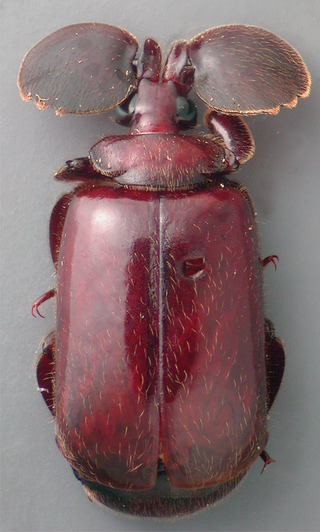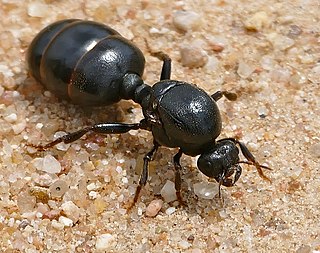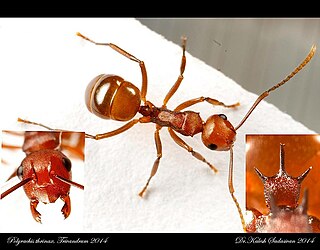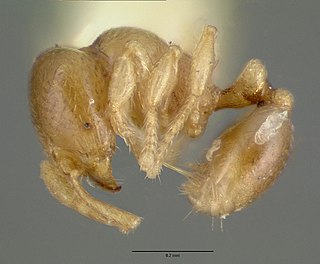
Carebara diversa, the East Indian harvesting ant, is a species of marauder ant widely distributed throughout Asia.

Platyrhopalopsis is a genus of flanged-bombardier beetles in the family Carabidae. They are found, as in others of the group, within ant nests, in the Indo-Malayan region. Adults are rarely seen except at lights. The flat terminal segment of the antenna is thought, based on studies of pupal development, to be formed by the fusion of multiple antennomere segments. The genus, placed by some in the tribe Platyrhopalina, includes the following three species:

Myopopone is a genus of ants in the subfamily Amblyoponinae. The genus contains two species, one extant and one fossil. The type species Myopopone castanea is known from the Oriental and Indo-Australian regions, and China. The fossil species, Myopopone sinensis, is known from the Early Miocene.

Carebara is a genus of ants in the subfamily Myrmicinae. It is one of the largest myrmicine genera with more than 200 species distributed worldwide in the tropics and the Afrotropical region. Many of them are very tiny cryptic soil and leaf-litter inhabitants. They nest in rotten wood to which the bark is still adherent in the Afrotropical region, or may be lestobiotic nesting near other ant species. Some species are known to exist parasitically within termite nests. Little is known about the biology of the genus, but they are notable for the vast difference in size between queens and workers.

Myopopone castanea is a species of ant in the genus Myopopone. It was described by Smith in 1860.

Carebara vidua is a species of ant in the subfamily Myrmicinae. It is currently listed as endangered because it is overly consumed for protein and used for medicine.
Carebara escherichi is a species of ant in the subfamily Formicinae. It is found in Sri Lanka.
Carebara bruni is a species of ant in the subfamily Myrmicinae. It is found in Sri Lanka and China.
Carebara butteli is a species of ant in the subfamily Myrmicinae. It is found in Sri Lanka.
Carebara ceylonensis is a species of ant in the subfamily Formicinae. It is found in Sri Lanka.
Carebara deponens is a species of ant in the subfamily Formicinae. It is found in Sri Lanka.
Carebara nana is a species of ant in the subfamily Formicinae, first described in 1863 by Julius Roger as Pheidologeton nanus. It is found in Sri Lanka.
Carebara pygmaea is a species of ant in the subfamily Formicinae. It is found in Sri Lanka, Borneo, Indonesia, Philippines.
Carebara sinhala is a species of ant in the subfamily Formicinae. It is found in Sri Lanka.

Polyrhachis thrinax is a species of ant in the subfamily Formicinae, found in many Asian countries. There are 6 or 7 subspecies recognized.

Carebara armata is a species of ant from the subfamily Myrmicinae. The scientific name of this species was first published in 1948 by Horace Donisthorpe.

Platyrhopalopsis melleii is a species of ant-nest or flanged bombardier beetle found in southern India. They live inside the nests of ants of the genus Carebara and adults are only rarely seen in the open, most often at night when they get attracted to lights.







